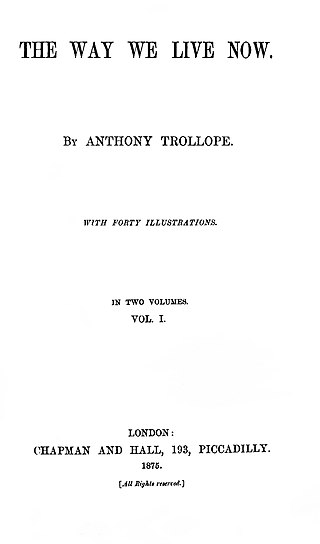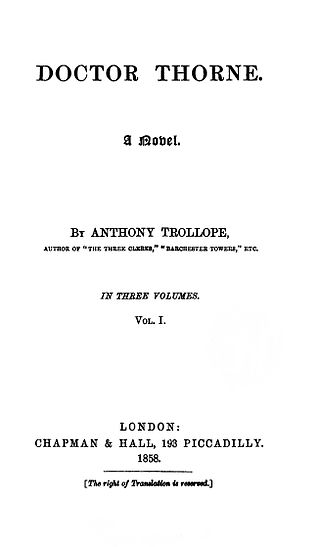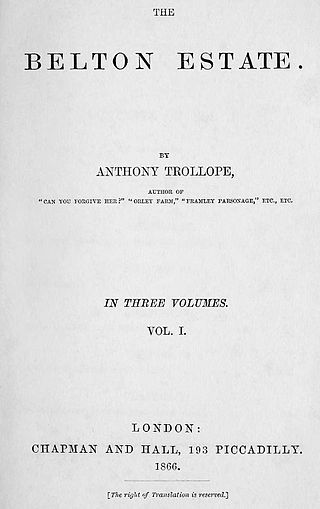
Anthony Trollope was an English novelist and civil servant of the Victorian era. Among his best-known works is a series of novels collectively known as the Chronicles of Barsetshire, which revolves around the imaginary county of Barsetshire. He also wrote novels on political, social, and gender issues, and other topical matters.

Phineas Finn is a novel by Anthony Trollope and the name of its leading character. The novel was first published as a monthly serial from 1867–1868 and issued in book form in 1869. It is the second of the "Palliser" series of novels. Its sequel, Phineas Redux, is the fourth novel in the series.

Phineas Redux is a novel by Anthony Trollope, first published between 1873 and 1874 as a serial in The Graphic. It is the fourth of the "Palliser" series of novels and is a sequel to the second book of the series, Phineas Finn.

The Duke's Children is a novel by Anthony Trollope, first published between 1879 and 1880 as a serial in All the Year Round. It is the sixth and final novel of the Palliser series. In 2020, the original text of The Duke's Children was restored for publication of a new edition led by editor Steven Amarnick.

The Eustace Diamonds is a novel by Anthony Trollope, first published between 1871 and 1873 as a serial in the Fortnightly Review. It is the third of the "Palliser" series of novels, though the characters of Plantagenet Palliser and his wife Lady Glencora are only in the background.

The Last Chronicle of Barset is a novel by English author Anthony Trollope, published in 1867. It is the sixth and final book in the Chronicles of Barsetshire series, preceded by The Small House at Allington. The novel is set in the fictional county of Barsetshire and deploys characters from the earlier novels, whilst concentrating on the personnel associated with the cathedral. The main narrative thread is catalysed by the loss of a cheque which had been in the possession of the Reverend Josiah Crawley, and the subsequent reactions of his friends and enemies. Trollope drew inspiration from his father and mother in the creation of the Rev. and Mrs. Crawley. In his autobiography, Trollope regarded this novel as "the best novel I have written.", although later commentators do not agree with this judgement. The serialisation was illustrated by G H Thomas who was selected by the publisher, though Trollope had wished for Millais who had illustrated The Small House at Allington.

The Way We Live Now is a satirical novel by Anthony Trollope, published in London in 1875 after first appearing in serialised form. It is one of the last significant Victorian novels to have been published in monthly parts.

Doctor Thorne is the third novel written by Anthony Trollope in his Chronicles of Barsetshire series, between Barchester Towers and Framley Parsonage. It was published by Chapman and Hall in London in 1858. The idea of the plot was suggested to Trollope by his brother Thomas. Though set in Barsetshire, Barchester and its residents take little part in the proceedings. The novel is mainly concerned with money and position.

Can You Forgive Her? is a novel by Anthony Trollope, first published in serial form in 1864 and 1865. It is the first of six novels in the Palliser series, also known as the Parliamentary Novels.
The Palliser novels are six novels written in series by Anthony Trollope. They were more commonly known as the Parliamentary novels prior to their 1974 television dramatisation by the BBC broadcast as The Pallisers. Marketed as "polite literature" during their initial publication, the novels encompass several literary genres including: family saga, bildungsroman, picaresque, as well as satire and parody of Victorian life, and criticism of the British government's predilection for attracting corrupt and corruptible people to power.

The Pallisers is a 1974 BBC television adaptation of Anthony Trollope's Palliser novels. Set in Victorian era England with a backdrop of parliamentary life, Simon Raven's dramatisation covers six novels and follows the events and characters over two decades.

He Knew He Was Right is an 1869 novel written by Anthony Trollope which describes the failure of a marriage caused by the unreasonable jealousy of a husband exacerbated by the stubbornness of a willful wife. As is common with Trollope's works, there are also several substantial subplots. Trollope makes constant allusions to Shakespeare's Othello throughout the novel. Trollope considered this work to be a failure; he viewed the main character as unsympathetic, and the secondary characters and plots as much more lively and interesting, but it is one of his best known novels. It was adapted for BBC One in 2004 by Andrew Davies.
The Fortnightly Review was one of the most prominent and influential magazines in nineteenth-century England. It was founded in 1865 by Anthony Trollope, Frederic Harrison, Edward Spencer Beesly, and six others with an investment of £9,000; the first edition appeared on 15 May 1865. George Henry Lewes, the partner of George Eliot, was its first editor, followed by John Morley.

An Eye for an Eye is a novel by Anthony Trollope written between 13 September and 10 October 1870, but held back from publication until August 1878 when serialization began in the Whitehall Review. Publication in the form of a two volume novel was timed to coincide with the issue of the final serialized episodes in January 1879.
The American Senator is a novel written in 1875 by Anthony Trollope. Although not one of Trollope's better-known works, it is notable for its depictions of rural English life and for its many detailed fox hunting scenes. In its anti-heroine, Arabella Trefoil, it presents a scathing but ultimately sympathetic portrayal of a woman who has abandoned virtually all scruples in her quest for a husband. Through the eponymous Senator, Trollope offers comments on the irrational aspects of English life.

Ralph the Heir is a novel by Anthony Trollope, originally published in 1871. Although Trollope described it as "one of the worst novels I have written", it was well received by contemporary critics. More recently, readers have found it noteworthy for its account of a corrupt Parliamentary election, an account based closely on Trollope's own experience as a candidate.

The Belton Estate is a novel by Anthony Trollope, written in 1865. The novel concerns itself with a young woman who has accepted one of two suitors, then discovered that he was unworthy of her love. It was the first novel published in the Fortnightly Review.

The Claverings is a novel by Anthony Trollope, written in 1864 and published in 1866–67. It is the story of a young man starting out in life, who must find himself a profession and a wife; and of a young woman who makes a marriage of convenience and must accept the consequences of her decision.

Rachel Ray is an 1863 novel by Anthony Trollope. It recounts the story of a young woman who is forced to give up her fiancé because of baseless suspicions directed toward him by the members of her community, including her sister and the pastors of the two churches attended by her sister and mother.

The Vicar of Bullhampton is an 1870 novel by Anthony Trollope. It is made up of three intertwining subplots: the courtship of a young woman by two suitors; a feud between the titular Broad church vicar and a Low church nobleman, abetted by a Methodist minister; and the vicar's attempt to rehabilitate a young woman who has gone astray.

















